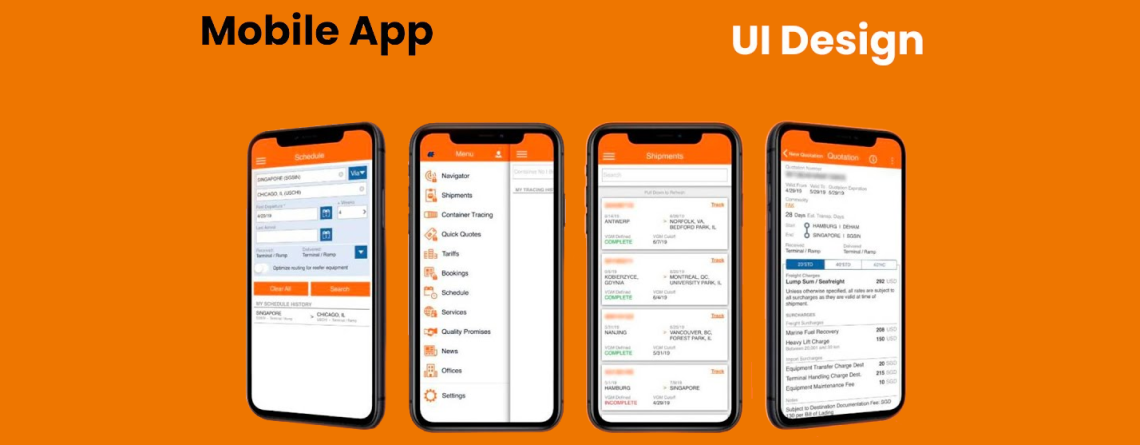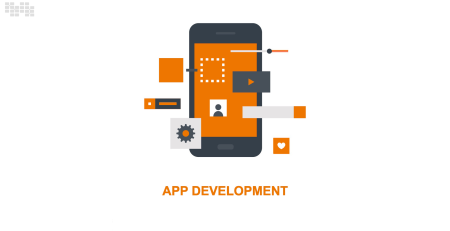Mobile App UI/UX Design Rules for Success
Table of Contents
This tutorial seeks to encompass all the fundamental principles for creating exceptional UI/UX designs that captivate people and bring about success. These days, smartphone applications are an essential part of our daily lives. The success of a smartphone application often depends on how effectively its user interface (UI) and user experience (UX) are built, whether we’re using it for managing our money, placing restaurant orders, or keeping in touch with loved ones. We will begin by discussing how important it is to understand user behavior before moving on to putting excellent principles into practice. Together, we will explore the essential ideas that may take your mobile application to new heights.
Understanding User Behavior
Comprehending user behavior is essential for developing effective UI/UX designs for mobile applications. Through acquiring knowledge about how people engage with digital interfaces, designers may customize their works to satisfy the requirements, inclinations, and expectations of users. While researching user behavior, keep the following important factors in mind:
- User Research: Conducting user research is the first step in understanding user behavior. This can involve techniques such as interviews, surveys, and ethnographic studies to gather insights into users’ goals, motivations, and pain points.
- User Personas: Creating user personas helps designers empathize with their target audience by representing different user demographics, behaviors, and preferences. Personas serve as fictional characters that embody the traits of real users, guiding design decisions and ensuring that the app meets the needs of its intended users.
- User Journey Mapping: User journey mapping involves visualizing the steps users take to accomplish their goals within the app. By mapping out the user journey, designers can identify pain points, friction points, and opportunities for improvement in the user experience.
- Behavioral Analytics: Utilizing analytics tools to track user behavior within the app provides valuable data on how users interact with different features, screens, and content. Analyzing metrics such as user engagement, retention, and conversion rates helps identify trends and patterns that inform design decisions.
- Usability Testing: Usability testing involves observing real users as they interact with prototypes or live versions of the app. Through usability testing sessions, designers can identify usability issues, navigation challenges, and areas of confusion, allowing them to make informed refinements to the UI/UX design.
- Contextual Inquiry: Contextual inquiry involves observing users in their natural environment as they use the app in real-world scenarios. This ethnographic research method provides insights into how contextual factors such as location, time, and device influence user behavior and decision-making.
- Accessibility Considerations: Understanding the diverse needs of users, including those with disabilities, is essential for creating inclusive UI/UX designs. Designers should consider accessibility guidelines and standards to ensure that the app is usable and accessible to all users, regardless of their abilities.
By prioritizing user behavior research and incorporating user-centric design principles into the UI/UX design process, designers can create mobile apps that resonate with users, drive engagement, and deliver exceptional user experiences.
Simplicity and Clarity in UI/UX
Effective mobile app UI/UX design is based on the core concepts of simplicity and clarity. Designers may build interfaces that are intuitive, simple to use, and enjoyable by putting a priority on clarity and simplicity. Here’s a closer look at the ways that clarity and simplicity support mobile app success:
- Clear Navigation: Making navigation as simple as possible is crucial to making sure users can navigate the app with ease. Give menus, buttons, and links—among other navigational elements—clear and informative labeling. Content should be arranged logically, with relevant features and information being grouped together. Reduce the amount of steps needed to do routine actions, making the user’s experience with the app more efficient.
- Minimalistic Design: Adopt a minimalist design philosophy to get rid of extraneous elements and concentrate on what matters most. Refrain from packing displays with of extraneous details or eye-cracking images. Increase the amount of white space between items to improve readability and visual hierarchy. Sort material according to the user’s objectives and demands, eliminating any features or unnecessary information that might be confusing.
- Consistent Layouts: To provide a seamless user experience, keep the layout and design aspects of the app consistent. For UI elements like buttons, forms, and cards, employ uniform patterns so that users will recognize the same elements on multiple displays. By removing the need for users to relearn interactions, consistency lowers cognitive strain and helps users predict how the app will operate.
- Clear Feedback: As consumers interact with app elements, provide them rapid, unambiguous feedback. To show the result of user activities, employ visual cues like animations, color changes, or progress indications. Feedback helps avoid mistakes or misunderstandings by confirming that the user understands how the software behaves.
- Accessible Language: When speaking with people, speak simply and plainly; stay away from jargon and technical terms that some users might not understand. Create clear, actionable labels, directions, and error messages that are both succinct and detailed. To make sure that linguistic and cultural variances are taken into account, take into account the criteria for localization and internationalization.
- Focus on Essential Features: Put the app’s most crucial features and functionalities first; move more complex or secondary functions to submenus or other screens. You may simplify the user experience and save people from becoming overwhelmed by needless complexity by concentrating on the elements that are truly important. Take into account progressive disclosure strategies to progressively show complex features to users as they gain app familiarity.
- User-Centered Design: Maintain the user’s perspective throughout the design process by asking for input often and making iterations based on user observation and testing. Recognize the requirements, preferences, and frustrations of users and provide solutions that alleviate those issues while improving the user experience as a whole. A thorough understanding of user behavior and a dedication to efficiently serving users’ demands are necessary for simplifying the user experience.
In summary, simplicity and clarity are guiding principles that help create mobile app UI/UX designs that are intuitive, efficient, and enjoyable to use. By prioritizing clear navigation, minimalistic design, consistent layouts, clear feedback, accessible language, focus on essential features, and user-centered design, designers can create mobile apps that resonate with users and drive success.
Consistency Across Platforms
Maintaining uniformity among platforms is essential to provide users a smooth and recognizable experience on any device or operating system. Sustaining uniformity in design components and user experiences across desktop, tablet, and smartphone platforms is beneficial for building user confidence, usability, and brand recognition. Here’s why maintaining consistency across platforms in the UI/UX design of your mobile app is important, and how to do it:
- Brand Recognition: Consistent design elements such as colors, typography, and logo placement reinforce brand identity and recognition. When users encounter familiar visual cues across different platforms, they feel confident that they’re interacting with the same brand, strengthening brand loyalty and trust.
- Usability and Familiarity: Consistent design patterns and interaction paradigms reduce cognitive load by allowing users to apply their existing knowledge and experience from one platform to another. When users know what to expect in terms of navigation, layout, and functionality, they can navigate the app more efficiently and with fewer errors.
- Cross-Platform Accessibility: In today’s multi-device world, users expect to access the same content and features seamlessly across different platforms. Consistency in design ensures that users can transition between devices without encountering jarring differences in the user interface or user experience.
- Efficiency in Development: Designing for consistency across platforms can streamline the development process by allowing designers and developers to reuse code, components, and design assets. Adopting a modular design approach enables teams to create reusable UI components that can be adapted to different platforms while maintaining a cohesive look and feel.
Here are some strategies for achieving consistency across platforms in your mobile app UI/UX design:
- Follow Platform Guidelines: Familiarize yourself with the design guidelines and best practices for each platform (e.g., iOS, Android, web). Platforms often have unique design patterns, navigation principles, and interaction guidelines that should be respected to ensure consistency and compatibility.
- Use Cross-Platform Design Systems: Implementing a cross-platform design system or UI toolkit allows you to create a unified set of design elements, components, and patterns that can be used across different platforms. Design systems help maintain consistency while providing flexibility for platform-specific adaptations.
- Adapt to Platform Conventions: Be aware of user expectations and platform-specific norms while preserving consistency. For instance, Android users are more acclimated to top-aligned tabs and back buttons, whereas iOS users are more used to bottom navigation bars and swipe movements. To make your app feel more natural and intuitive, make sure the interactions and design follow the norms of the platform.
- Test Across Devices and Platforms: Conduct thorough testing across various devices, screen sizes, and operating systems to ensure that your app looks and performs consistently across platforms. Pay attention to differences in typography, spacing, and layout that may arise when scaling your design to different screen sizes and resolutions.
- Iterate Based on User Feedback: Solicit feedback from users across different platforms to identify any inconsistencies or usability issues. Iterate on your design based on user feedback to refine and improve the consistency and usability of your app across platforms over time.
By prioritizing consistency across platforms in your mobile app UI/UX design, you can create a cohesive and familiar experience that delights users and reinforces your brand identity across all touchpoints.
Accessibility and Inclusivity
In order to ensure that users of all abilities and disabilities can easily use a mobile app, accessibility and inclusivity are important considerations to make during the app’s design process. You can help make the user experience more equitable and easy for everyone by giving accessibility and inclusion first priority. The following justifies your mobile app’s UI/UX design should take accessibility and inclusivity into account:
- Equal Access for All: Accessibility ensures that individuals with disabilities, including visual, auditory, motor, or cognitive impairments, can access and interact with your app without barriers. By designing with accessibility in mind, you provide equal access to information, functionality, and services for all users, promoting digital inclusion and diversity.
- Legal and Ethical Responsibility: Many countries have laws and regulations that require digital products, including mobile apps, to be accessible to people with disabilities. By complying with accessibility standards such as the Web Content Accessibility Guidelines (WCAG) or the Americans with Disabilities Act (ADA), you demonstrate a commitment to legal compliance and ethical responsibility.
- Expanded User Base: Designing for accessibility expands your app’s user base to include people with disabilities, seniors, and individuals with temporary or situational limitations. By making your app accessible to a broader audience, you increase your app’s reach and potential for engagement.
- Enhanced Usability for Everyone: Not just users with impairments but all users benefit from accessibility features rather frequently. For instance, subtitles and transcripts make multimedia information easier for consumers to access in calm or noisy settings. Both users with limited eyesight and those using the app in strong sunshine benefit from clear and readable font.
Here are some strategies for incorporating accessibility and inclusivity into your mobile app UI/UX design:
- Semantic HTML: Use semantic HTML markup to ensure that screen readers and assistive technologies can interpret and navigate the content of your app accurately. Use proper heading structure, alternative text for images, and ARIA (Accessible Rich Internet Applications) attributes to enhance accessibility for users with disabilities.
- Responsive Design: Design your app with responsiveness in mind to accommodate users with different screen sizes, resolutions, and orientations. Ensure that your app’s layout and functionality adapt seamlessly to various devices and viewport sizes, providing a consistent user experience across platforms.
- Color Contrast and Legibility: Use high-contrast color schemes and legible typography to improve readability for users with low vision or color blindness. Avoid relying solely on color to convey information and provide alternative visual cues such as icons, patterns, or labels.
- Keyboard Accessibility: Ensure that all interactive elements in your app, such as buttons, links, and form fields, are accessible via keyboard navigation. Allow users to navigate through the app, interact with controls, and submit forms using only the keyboard, without requiring mouse or touch input.
- Alternative Input Methods: Provide alternative input methods for users with motor disabilities who may have difficulty using traditional touch gestures or mouse inputs. Support input methods such as voice commands, gestures, or switch controls to accommodate diverse user needs.
- Testing with Assistive Technologies: Conduct usability testing with users who use assistive technologies such as screen readers, magnifiers, or alternative input devices. Gather feedback on the accessibility and usability of your app from users with disabilities to identify areas for improvement and refinement.
- Education and Awareness: Educate your team members, stakeholders, and collaborators about the importance of accessibility and inclusivity in UI/UX design. Foster a culture of accessibility awareness and advocacy within your organization to ensure that accessibility considerations are integrated into all stages of the design and development process.
By prioritizing accessibility and inclusivity in your mobile app UI/UX design, you can create a more equitable, user-friendly, and inclusive experience for all users, regardless of their abilities or disabilities. Investing in accessibility benefits not only users with disabilities but also your app’s usability, reach, and reputation in the long run.
Visual Feedback and Affordances
Visual feedback and affordances play a crucial role in guiding users through a mobile app and enhancing their overall user experience. These design principles help users understand how to interact with elements within the app, provide feedback on their actions, and indicate the current state of the interface. Let’s explore why visual feedback and affordances are important and how they can be effectively implemented in mobile app UI/UX design:
- Guidance and Clarity: Visual feedback helps users understand the outcome of their actions and provides guidance on how to interact with different elements within the app. By providing clear visual cues, such as animations, color changes, or visual highlights, users can easily identify interactive elements and understand their functionality.
- User Engagement: Interactive feedback enhances user engagement by making the app’s interface more responsive and dynamic. When users receive immediate visual feedback in response to their actions, they feel more engaged and in control of their interactions, leading to a more immersive and enjoyable user experience.
- Error Prevention and Recovery: Visual feedback can help prevent errors by indicating when a user’s action is invalid or incomplete. By providing timely feedback and error messages, users can quickly correct their mistakes and avoid frustration. Additionally, visual feedback can reassure users when their actions are successful, such as submitting a form or completing a task.
- Affordances and Signifiers: Visual signals known as affordances indicate how an element may be utilized or interacted with. For instance, pushing or tapping is possible with a button that seems elevated and has shadowing. Conversely, signifiers—such as a tooltip or instructive text—offer clear directions or clues regarding an element’s capabilities. Users may interact with various components of the app in a straightforward manner by integrating affordances and signifiers into its design.
Here are some strategies for incorporating visual feedback and affordances into your mobile app UI/UX design:
- Interactive Animations: Use animations to provide visual feedback on user interactions, such as button presses, swipes, or transitions between screens. Animated effects, such as button depressions, loading spinners, or content transitions, create a sense of responsiveness and fluidity, enhancing the user experience.
- Color and Contrast: Utilize color and contrast to highlight interactive elements and indicate their state. For example, changing the color of a button when it’s pressed or disabled provides visual feedback on its availability and status. Ensure that color choices comply with accessibility guidelines and maintain sufficient contrast for readability.
- Microinteractions: Implement microinteractions to provide subtle but meaningful feedback on user actions. Microinteractions are small, contained animations or visual effects that respond to user input, such as liking a post, dragging an item, or swiping to refresh content. These interactions add personality to the app and create moments of delight for users.
- Progress Indicators: Use progress indicators to inform users about the status of ongoing tasks or operations. Whether it’s uploading a file, downloading content, or processing a payment, progress indicators keep users informed and alleviate uncertainty about the app’s responsiveness.
- Feedback Icons and Labels: Incorporate visual icons or labels to accompany interactive elements and provide additional context or guidance. Icons can convey the intended action of a button, while labels or tooltips offer descriptive text to clarify its purpose. Ensure that icons and labels are intuitive and universally understood to avoid confusion.
- Consistent Feedback Patterns: Maintain consistency in visual feedback patterns throughout the app to establish familiarity and predictability for users. Use standardized visual cues for common interactions, such as confirmation dialogs, error messages, or success notifications, to ensure a cohesive user experience.
By integrating visual feedback and affordances into your mobile app UI/UX design, you can create an intuitive, engaging, and user-friendly experience that guides users through the app and provides meaningful interactions. Visual feedback enhances usability, encourages exploration, and reinforces user confidence, ultimately contributing to the success of your app.
Performance Optimization
In order to guarantee that a mobile app loads rapidly, reacts to user inputs promptly, and provides a flawless user experience, performance optimization is crucial to UI/UX design. Poor or slow performance has a detrimental effect on user satisfaction and retention since it can irritate consumers and cause them to give up. Performance optimization is important, and here’s how to include it into your mobile app’s UI/UX design:
- User Expectations: Users expect mobile applications to load and reply virtually instantaneously in today’s fast-paced digital environment. Users may become irritated and impatient with slow performance, leaving the app and looking for alternatives. By meeting consumers’ demands for responsiveness and speed through performance optimization, you improve their experience as a whole.
- User Engagement: Performance optimization contributes to user engagement by minimizing wait times and interruptions during interactions. When users can navigate the app smoothly and access content quickly, they’re more likely to stay engaged and explore further. Improved performance encourages longer sessions and deeper interactions, fostering a stronger connection between users and the app.
- Conversion Rates: Performance optimization directly impacts conversion rates by reducing friction in the user journey and streamlining the path to conversion. Whether it’s completing a purchase, submitting a form, or accessing content, fast and efficient performance increases the likelihood of users completing desired actions. A smooth and responsive user experience encourages users to convert and contributes to the app’s success.
- Bandwidth and Data Usage: Optimizing performance is particularly important for users with limited bandwidth or data connectivity, such as those on mobile networks or in areas with poor reception. By minimizing the amount of data transferred and optimizing resource usage, you ensure that the app remains accessible and usable even under challenging network conditions.
Here are some strategies for implementing performance optimization in your mobile app UI/UX design:
- Optimize Images and Media: Compress and optimize images and multimedia content to reduce file sizes and minimize loading times. Use appropriate image formats, sizes, and compression techniques to maintain visual quality while optimizing performance. Lazy loading techniques can also be used to defer the loading of non-essential images until they’re needed, improving initial load times.
- Minimize Network Requests: Reduce the number of network requests and minimize latency by consolidating resources, such as CSS, JavaScript, and API calls. Combine and minify CSS and JavaScript files to reduce file size and decrease the number of HTTP requests required to load the app. Use caching mechanisms to store and reuse resources whenever possible, further reducing network overhead.
- Optimize Code and Rendering: Write clean, efficient code and optimize rendering performance to ensure smooth interactions and animations. Use hardware-accelerated animations and transitions for smoother rendering on supported devices. Implement techniques such as requestAnimationFrame() for optimal performance during animation playback.
- Prioritize Content Loading: Prioritize the loading of essential content and functionality to provide users with a fast and responsive initial experience. Load critical resources asynchronously or in parallel to ensure that the app’s core features are available as quickly as possible. Display placeholders or skeleton screens to indicate progress and reassure users while content is loading.
- Monitor and Test Performance: Continuously monitor and test the app’s performance across different devices, platforms, and network conditions. Use performance monitoring tools and analytics to identify bottlenecks, slow-loading resources, or areas for improvement. Conduct usability testing to evaluate the impact of performance optimization on user satisfaction and engagement.
- Optimize Battery and Resource Usage: Consider the impact of performance optimization on device battery life and resource usage. Minimize CPU and battery usage by optimizing code execution, reducing background processes, and optimizing animations and transitions. Balancing performance with energy efficiency ensures a positive user experience without compromising device performance or battery life.
By prioritizing performance optimization in your mobile app UI/UX design, you can create a fast, responsive, and user-friendly experience that delights users and drives engagement. Investing in performance optimization benefits not only user satisfaction but also conversion rates, retention, and overall app success in the competitive mobile landscape.
Personalization and Contextualization
Effective UI/UX design techniques for mobile apps include personalization and contextualization, which adjust the user experience to each user’s unique choices, actions, and circumstances. Mobile applications have the power to give consumers more relevant, meaningful, and engaging experiences by providing them with tailored information, interactions, and suggestions. The following explains the importance of customization and contextualization in mobile app UI/UX design, as well as how to handle them well:
- Enhanced User Engagement: Personalization and contextualization increase user engagement by delivering content and features that are relevant and tailored to each user’s interests and preferences. When users feel that the app understands their needs and provides valuable, personalized recommendations or suggestions, they’re more likely to engage with the app regularly and for longer periods.
- Improved User Satisfaction: Personalized experiences enhance user satisfaction by reducing the time and effort required to find relevant content or complete tasks within the app. By anticipating users’ needs and proactively delivering personalized recommendations or reminders, the app enhances usability and convenience, leading to higher user satisfaction and loyalty.
- Increased Conversion Rates: Personalization and contextualization can drive conversion rates by delivering targeted messages, offers, and recommendations that align with users’ interests and behaviors. By presenting users with relevant products, services, or content based on their past interactions or preferences, the app increases the likelihood of conversion and drives revenue growth.
- Deeper User Insights: Personalization and contextualization provide valuable insights into user behavior, preferences, and intent. By analyzing user data and interactions, the app can identify patterns, trends, and opportunities for optimization, enabling more informed decision-making and iterative improvements to the user experience.
Here are some strategies for incorporating personalization and contextualization into your mobile app UI/UX design:
- User Profiles and Preferences: Create user profiles to capture and store information about users’ preferences, behaviors, and demographics. Allow users to customize their profiles and preferences within the app, enabling them to control their personalization settings and tailor the experience to their liking.
- Behavioral Tracking and Analysis: Track user interactions and behaviors within the app to gather insights into their preferences, interests, and intent. Analyze user data to identify patterns and trends, such as frequently accessed content, preferred features, or recurring tasks, and use this information to personalize the user experience accordingly.
- Personalized Content Recommendations: Leverage user data and machine learning algorithms to deliver personalized content recommendations, such as articles, products, or videos, based on users’ past interactions and preferences. Present recommendations prominently within the app’s interface, such as on the home screen or in dedicated recommendation sections, to encourage exploration and engagement.
- Context-Aware Features and Notifications: Use contextual information, such as location, time of day, or device type, to deliver relevant and timely notifications, alerts, or offers to users. For example, a weather app can provide personalized weather forecasts based on the user’s current location, while a fitness app can offer workout suggestions based on the time of day and the user’s activity history.
- Adaptive User Interfaces: Create user interfaces that are dynamically adjusted according to user choices, device capabilities, and surrounding circumstances. Permit users to alter the layout, color scheme, and font size of the app’s interface to better fit their own tastes and accessibility requirements. To maximize the user experience across many devices and scenarios, adjust the app’s functionality and content display according on contextual circumstances, such as screen size, orientation, or network availability.
- Progressive Disclosure and Onboarding: Implement progressive disclosure techniques to gradually reveal advanced features or personalized content as users become more familiar with the app. Use onboarding experiences to introduce users to personalized features and encourage them to complete their profiles or set up personalization preferences during the initial app setup process.
- Feedback and Iteration: Solicit feedback from users on their personalized experiences and iterate based on their input and preferences. Allow users to provide feedback on recommended content, product suggestions, or personalized features to refine and improve the personalization algorithms over time. Continuously monitor user engagement and satisfaction metrics to assess the effectiveness of personalization efforts and make data-driven adjustments as needed.
By prioritizing personalization and contextualization in your mobile app UI/UX design, you can create a more engaging, relevant, and tailored experience that delights users and drives user engagement, satisfaction, and conversion rates. Investing in personalization benefits both users and the app’s success by delivering value, relevance, and convenience in an increasingly competitive digital landscape.
Testing and Iteration
In order to modify and improve the user experience based on feedback and data-driven insights, testing and iteration are crucial steps in the mobile app UI/UX design process. The design, functionality, and performance of the app may be iteratively improved by designers by gathering user input, doing extensive testing, and going through iteration cycles. The following explains the significance of testing and iteration and how to successfully include them in the UI/UX design process for mobile apps:
- User-Centric Design: Testing and iteration prioritize the user’s perspective by placing their needs, preferences, and feedback at the forefront of the design process. By involving real users in the testing process, designers gain valuable insights into user behavior, expectations, and pain points, allowing them to design solutions that address users’ needs effectively.
- Identifying Usability Issues: Testing helps identify usability issues, such as navigation challenges, confusing interface elements, or performance bottlenecks, that may hinder the user experience. By observing users as they interact with the app and gathering feedback on their experiences, designers can pinpoint areas for improvement and make informed design decisions.
- Gathering User Feedback: Testing provides an opportunity to gather qualitative and quantitative feedback from real users, allowing designers to understand users’ perceptions, preferences, and satisfaction with the app. Through methods such as usability testing, surveys, and user interviews, designers can collect valuable insights into user behavior and preferences, informing iterative design improvements.
- Iterative Improvement: Iteration involves making incremental improvements to the app’s design, functionality, and performance based on feedback and data-driven insights. By embracing a cycle of testing, feedback, and iteration, designers can refine the user experience over time, continuously improving usability, engagement, and satisfaction.
Here are some strategies for incorporating testing and iteration into your mobile app UI/UX design process:
- Usability Testing: Conduct usability testing sessions with real users to observe how they interact with the app and identify usability issues. Provide users with specific tasks to complete within the app and observe their behavior, interactions, and feedback. Use usability testing to gather insights into navigation challenges, comprehension issues, and user satisfaction with the app’s design and functionality.
- A/B Testing: Implement A/B testing to compare different variations of design elements, features, or user flows and determine which version performs better in terms of user engagement, conversion rates, or other key metrics. Test variations of UI elements, messaging, or functionality to identify the most effective design solutions and iterate based on the results.
- Remote User Testing: Use remote user testing tools and platforms to gather feedback from a diverse pool of users, regardless of their location. Remote testing allows designers to reach a broader audience and gather insights from users with different backgrounds, preferences, and device configurations.
- Analytics and Data Analysis: Analyze user analytics and behavioral data to gain insights into user interactions, patterns, and trends within the app. Use quantitative data such as user engagement metrics, conversion rates, and retention rates to identify areas for improvement and prioritize design enhancements.
- Feedback Loops: Create user feedback loops to collect continuous feedback and insights during the design process. Through user forums, in-app surveys, or feedback forms, ask users for their opinions. Then, utilize their responses to guide iterative design changes. Pay attention to what users have to say, address any issues they may have, and let them know how your suggestions are being used to improve the app.
- Iterative Prototyping: Create iterative prototypes of the app’s design and functionality to test different design concepts and gather feedback early in the design process. Use prototyping tools to create interactive prototypes that simulate the app’s user interface and interactions, allowing users to provide feedback on the app’s usability and functionality before it’s fully developed.
- Continuous Improvement: Embrace a culture of continuous improvement by iterating on the app’s design based on ongoing testing, feedback, and data analysis. Prioritize iterative improvements that address the most critical usability issues, enhance user satisfaction, and align with the app’s strategic goals and objectives.
By incorporating testing and iteration into your mobile app UI/UX design process, you can create a user-centered, data-driven approach to design that prioritizes usability, engagement, and satisfaction. Investing in testing and iteration benefits both users and the app’s success by identifying and addressing usability issues, gathering valuable user feedback, and continuously improving the user experience over time.













Leave a Reply